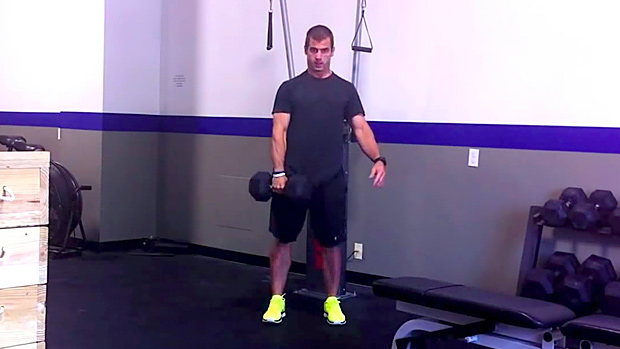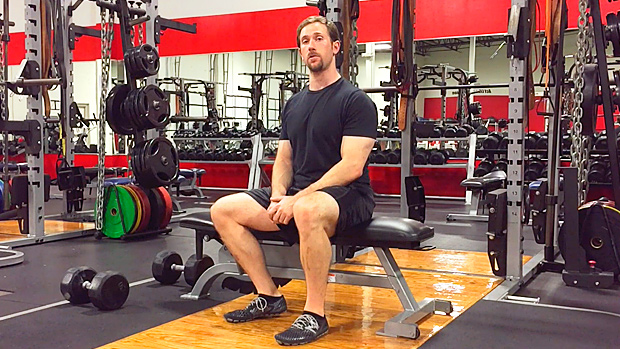You don't have to overhaul your workouts. Instead, ramp up the horsepower of your training using these strategies. If you apply all five, your gym buddies will start wondering what you're on.
1 Use Time Constraints
When resting between sets, there's a fine line between recovery and procrastination. Parkinson's Law states that work tends to expand to fill the time allotted for its completion. Put another way, you can probably rest less between sets without negative consequences. That means shorter, more effective workouts, and having more time outside the gym.
Maximize training efficiency by setting time limits for each exercise. If you're planning to do 4 sets of 8 on bentover rows, think about how many warm-up sets you'll need (let's say it's 3) and then add that to your work sets. So in this example, we're looking at 7 total sets.
In order to determine how much time to give yourself per exercise, estimate the length of each set and rest period. Allot 30 seconds for each set, and 2.5 minutes between sets. That gives you a total of 21 minutes to complete your rows.
Why time exercises rather than sets? If you use the same rest interval for every set, your efforts are inefficient because warm-up sets don't require as much rest as work sets, and early work sets don't need as much rest as your later work sets.
By setting a time limit for the whole exercise, rather than for each set, you can front-load your efforts by resting less for earlier sets and longer during later sets when you've accumulated more fatigue and need extra recovery.
Do more of the exercises that don't require a long warm-up. No exercise is purely good or bad. That goes for your favorites too. Think about the barbell back squat. It's considered the irrefutable hallmark of true masculinity, and only wussies use machines. Yup, gotcha.
Except, maybe you're time-starved and you really need some leg mass so that you at least look like you lift. And maybe, just maybe, you could get a much better growth stimulus with leg presses or hack squats, because frankly, they require much less in the way of warm-up sets, and also because they don't trash your low back the way barbell squats do for most people.
This example might not be great for competitive powerlifters, but if that's not you and you simply want to be bigger and stronger, who cares how you get there? Do you have any idea how many massively-jacked bodybuilders developed their gigantic legs using leg presses and hack squats?
Another low-prep movement is the glute bridge or hip thrust. It requires virtually no warm up, even with heavy weights. Try doing them right after deadlifts, since you've already got a loaded barbell ready to go.

In terms of loading parameters, Pavel Tsatsouline's "ladder" protocol is a very efficient way to rack up a lot of volume fast. Set one is 1 rep, set two is 2 reps, set three is 3 reps until you're a rep or two away from failure. That's one ladder. Then hit your second ladder. Apply time constraints on this exercise, or perhaps as many total reps as you can rack up in 20 minutes.
Don't get too distracted by these examples. Instead, think about your training goals and whether your exercises of choice are helping you accomplish them. What are the upsides and downsides to the exercises you're currently using? Do they require lots of warming up, equipment set up, or skills you really don't have down yet? Are there faster, simpler tools at your disposal?
The old "hit the muscle from all angles" and "muscle confusion" tactics both contain a kernel of truth, but are usually misapplied. Keeping the gains coming has a lot to do with finding novel challenges for your muscles. Problem is, if you decide to do every exercise you know for upper back for the next 6 weeks, what exercises will you use during the 6-week cycle after that?
Another problem is that the more exercises you use, the more warm-up sets you'll need. Warm-ups are necessary, but alone they don't contribute toward the adaptations you're looking for.
A better approach is to take a few good exercises per muscle group and per cycle, then just hammer the shit out of them each workout. If you're currently using 4 hamstring movements, using 4 sets of 8 for each, try whittling that down to 2 exercises and 8 sets per exercise. This type of narrowly-focused training stress will drive growth through the roof. Then, after 4-6 weeks when your muscles have finally accommodated, you substitute two new exercises for the following cycle.
The bottom line is that hitting your muscles from different angles with different exercises is a good idea, but it doesn't (and shouldn't) be done simultaneously.
You're either interested in more muscle, more strength, or both. And it'll pay to apply specific tactics to your training for that goal.
For more muscle: The primary stimulus for muscle hypertrophy is the total volume of work. So focus on exercises that allow for large ranges of motion. Dumbbell bench presses, not floor presses for example.
You'll also want to arrange your loading parameters in a way that allows for maximum volume. This means relatively light weights for relatively high reps. Can you grow muscle doing heavy sets of three? Sure, but it'll take lots of triples to reach the same volume you'd otherwise hit doing sets of 10. Read: long-ass workouts.
Building muscle also depends on "feel" more than developing strength does. So in your hypertrophy phases, prioritize the mind-muscle connection. This will require minimal body-english, slower tempos, and in general, finding ways to make (relatively) light weights feel heavy.
For more strength: You'll need slightly different tactics. Now the main priority is bar weight and exercises that permit the safe use of heavy loads. Think squats, barbell bench presses, pull-ups, military presses, and deadlifts. In terms of weekly progression, when push comes to shove, sacrifice reps for weight, not vice versa.
Finally, remember that since strength training requires the use of heavy weights, you'll need more warm-up sets, which means that you'll need to use fewer exercises than when training for hypertrophy.
This is about perspective. Most lifters get caught up in what happens during a particular set, as opposed to the entire workout, week, or training cycle.
Imagine that you applied this myopic mindset to your diet. You tell a buddy, "Dude, the lunch I ate yesterday was totally dialed in – 30 grams of protein, 30 grams of carbs, and 5 grams of fat!" At which point your friend is thinking, "Who cares that your lunch was perfect? What did you eat for the rest of the day?"
Training is a process, not a one-time event. And while it certainly matters how hard (and smart) you work during each set, it's the bigger picture that matters most.
Think about the notion of training to failure. If you're training for muscle growth and on your first work set you went right to the wall with 12 reps, it's very probable that the rest of your work sets would suffer as a result.
In another example, while it would certainly be impressive to squat your bodyweight for 50 reps, if that effort trashed you to the point that the rest of your training week sucked, it would be a net loss. Intensity is only beneficial if it can be sustained long-term. Getting stronger and more muscular takes lots of time. Make sure you're in for the long game!
Don't be one of those guys who knows a lot, but doesn't look the part. Start employing these strategies right away and enjoy the satisfaction of workouts that are maximally effective.





